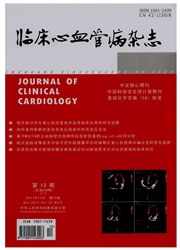

 中文摘要:
中文摘要:
目的:探讨临床广泛使用的第四代氟喹诺酮类抗生素——加替沙星致室性心律失常的机制。方法:制作兔左室楔形心肌块模型,将30只健康新西兰长耳兔随机分为正常组、加替沙星组和低钾低镁组(低钾组),每组各10只。正常组灌流正常台式液,加替沙星组灌流19mmol/L加替沙星30min,低钾组灌流同浓度但溶于低钾低镁液的加替沙星30min。采用浮置玻璃微电极法同步记录各组内、外膜下心肌动作电位和跨壁心电图,观察灌流过程中心律失常发生率,QT间期和TDR(跨室壁离散度)的变化。结果:1与正常组比较,加替沙星组和低钾组的QT明显延长;TDR,EAD(早后除极)和TdP(尖端扭转型室速)的发生率亦明显增大(P〈0.05)。2与加替沙星组比较,低钾组的QT和TDR差异未见统计学意义(P〉0.05)。3与加替沙星组比较,低钾组的EAD和TdP的发生率明显增大(P〈0.05)。结论:在加替沙星合并低钾低镁条件下易诱发Tdp及EAD等恶性心律失常。
 英文摘要:
英文摘要:
Objective..Gatifloxacin has a broad spectrum of antimicrobial activity and is widely prescribed in the treatment of infections. The aim of this study is to evaluate the arrhythmogenic mechanism of gatifloxacin using perfused rabbit left ventricular wedge preparations. Method.. Thirty arterially perfused rabbit left ventricular wedge preparations were randomly divided into Control group (perfused with tyrode's solution, n : 10), gatifloxacin group (perfused with 19 mmol/L gatifloxacin, n = 10), hypopotassemia and hypomagnesemia group (perfused with 19 mmol/L Gatifloxacin and hypopotassemia and hypomagnesemia tyrode's solution, n= 10). Floating glass microelectrodes were utilized to simultaneously record transmural ECG and action potentials from both endocardi- um and epicardium. The rates of arrhythmia, changes of QT interval and TDR were analysed. Result: 1Compared with control group , the QT interval and TDR were increased in gatifloxcin group(P〈0.05). And the incidences of EAD and TdP were also higher in gatifloxcin group(P〈0.05). 2No significant differences of the QT interval and the TDR were observed between the gatifloxcin group and the hypopotassemia hypomagnesemia group(P~ 0.05). 3Compared with the gatifloxcin group, the incidence of EAD and TdP is significant higher in the hypopo- tassemia and hypomagnesemia group(3/10 vs 9/10, 2/10 vs 6/10,P〈0.05). Conclusion.. EAD is a trigger factor and TDR is the maintenance reason of TdP in arterially perfused with gatifloxacin in rabbit left ventricular wedge preparation under hypopotassemia and hypomagnesemia condition.
 同期刊论文项目
同期刊论文项目
 同项目期刊论文
同项目期刊论文
 Worldwide Experience with the Robotic Navigation System in Catheter Ablation of Atrial Fibrillation:
Worldwide Experience with the Robotic Navigation System in Catheter Ablation of Atrial Fibrillation: Ablation of Perimitral Flutter Following Catheter Ablation of Atrial Fibrillation: Impact on Outcome
Ablation of Perimitral Flutter Following Catheter Ablation of Atrial Fibrillation: Impact on Outcome 期刊信息
期刊信息
